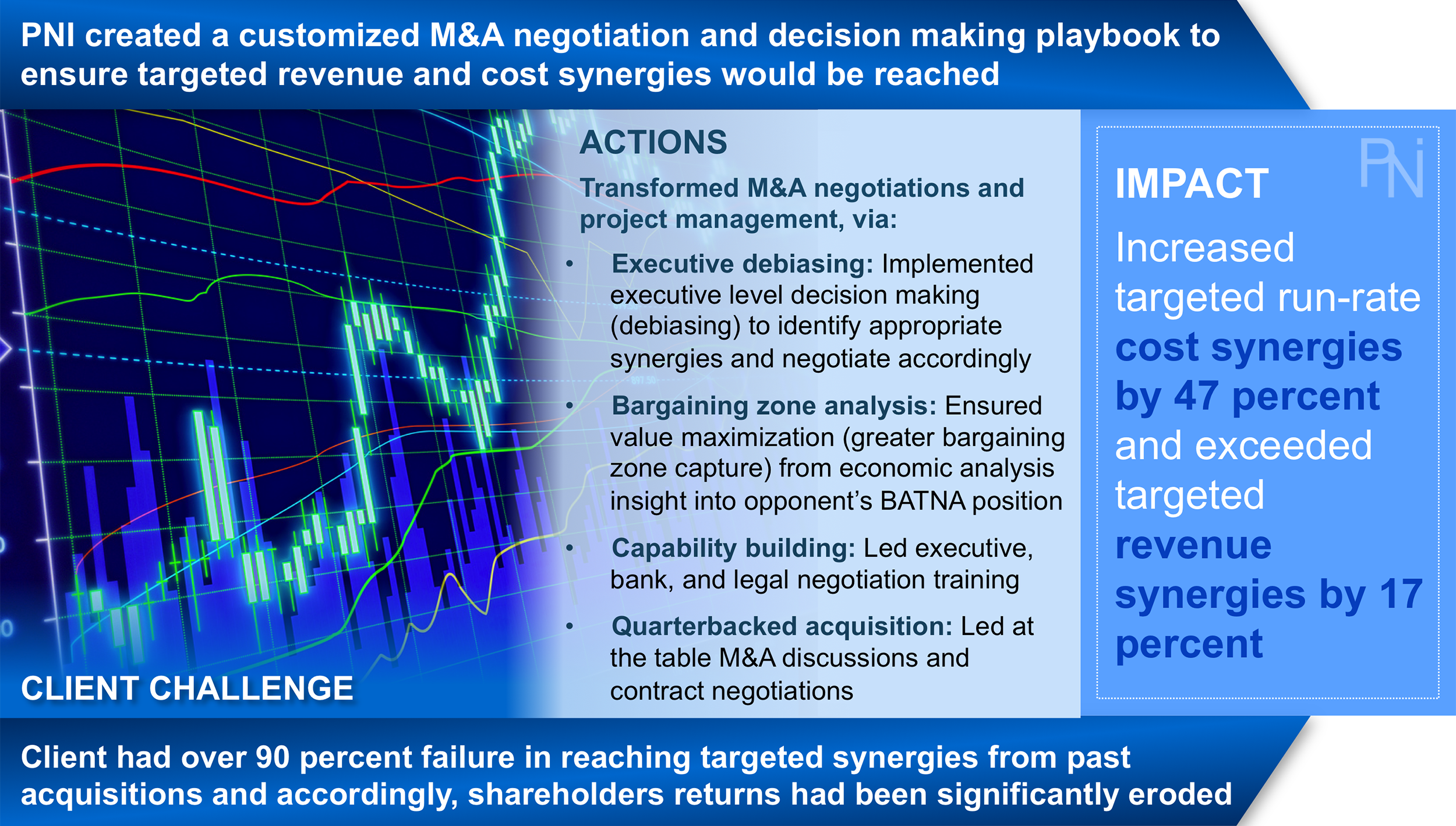Overview
DECISION-MAKING TRANSFORMATION FRAMEWORK
Exhibit 1 (Click to Enlarge)
CORPORATE DECISION-MAKING GAP™
Exhibit 2 (Click to Enlarge)
360° OMNI-STAGE DECISION-MAKING™
Exhibit 3 (Click to Enlarge)
Poor decision-making is oftentimes the number one culprit for why companies fail and/or see stagnant growth. Simply, left unchecked, subconscious biases (1) undermine corporate decision-making, (2) create a toxic culture, (3) lead to stagnant growth, and (4) drive negative ROI. On the opposite side of this spectrum, those that improve their decision making can witness substantial growth, including ROI increases of 7 percent and greater (Exhibit 2). Simply, decision-making can either be value erosive or value maximizing. PNI helps the world's most sophisticated companies transform its decision-making capabilities via leveraging our proprietary 6-step decision-making framework and our 360° Omni-Stage Decision-Making™, ensuring mitigation of enterprise wide value erosive decision-making (See Exhibits 1, 2, and 3).
In a recent McKinsey survey of 772 board members, including over 200 chairmen, respondents ranked improving decision-making as their No. 1 aspiration for how to improve their performance. Yet, according to our own surveys as well as research by behavioral economists, very few corporations implement measures to improve decision-making and mitigate cognitive biases. This ultimately leads to value erosive decisions that deviate from rational calculations. Indeed, behavioral economics indicate that corporations and its leaders are often not rational as decision makers, and that this irrationality is quite predictable. Furthermore, Nobel Laureate Daniel Kahneman has demonstrated how biases lead to sub-optimal value eroding decisions – decisions that are diametrically opposed to the rational choices assumed by classical economics.
Exhibit 4 (Click to Enlarge)
Exhibit 5 (Click to Enlarge)
For example, we’ve found that companies that exhibit a greater number of biases are 32 percent more likely to pass up good investments. In addition, we see that biases can decrease the returns on a company’s investments by 31 percent (See Exhibit 4). On the opposite side of this spectrum, those who improve their decision making from the bottom to top quartile can see at least a 7 to 9 percent ROI increase (See Exhibit 5). Simply, decision making can either be value erosive or value maximizing. Indeed, many executives have also shown dissatisfaction with their decision-making. In one of our recent surveys which included ~1,500 Fortune 500 executives, reducing decision biases was ranked as the number 1 aspiration for improving performance. Simply, these executives believed the following:
- 76 percent were taking too much or too little risk
- 67 percent were over or under investing
- 93 percent did not reach target forecasts
In a couple recent McKinsey surveys executives illustrated the following:
- Only 28 percent said that the quality of strategic decisions in their companies was generally good due to prevailing biases
- 60 percent thought that bad decisions were about as frequent as good ones
- Raising a company’s decision-making process (decreasing biases) from the bottom to the top quartile improved its ROI by 6.9 percentage points.
Decision-Making Gap™
Corporate Decision-Making Gap™
Exhibit 6 (Click to Enlarge)
Failure to consider the entire decision-making lifecycle leads to stagnant growth, poor productivity, diluted resources, and ultimately declining profitability. Simply, this stems from a corporate decision-making gap™ (See Exhibit 6).
SITUATION: The number of steps involved across any successful decision-making lifecycle is often far greater and requires more in depth rigor and analysis than most companies consider. Many organizations merely consider each step as they move through the process but only go as deep as they should once they actually come to that stage or are confronted with a pain point. Simply, a linear trajectory is followed which is equivalent to someone walking along a sidewalk with tunnel vision. They only see what is ahead and course correct once they arrive at a problem in the road. This stems from a “multi-stage” instead of a “360° omni-stage™” decision-making mindset.
COMPLICATION: A byproduct from this lack of analysis and rigor within the decision-making lifecycle is stagnant growth from unsuccessful initiatives such as failed acquisitions, poor transformations, slow time to market (i.e., lost opportunities and market share), and biased decision-making. This is more prevalent than ever with over half of the S&P 500 predicted to be out of business within the next decade.
RESOLUTION: Making profitable corporate decisions can be analogized to a 1x1 matrix. Simply, companies must find the right balance between (1) the evaluation of the number of relevant value defining steps in the lifecycle of the decision (i.e., Y-Axis = % of Lifecycle Analyzed) and (2) the depth of analysis for each relevant point (i.e., X-Axis = Depth of Analysis). This can be accomplished by analyzing the journey from a 360° omni-stage view via (1) past learnings, (2) current considerations and pain points, and (3) future issues that could arise. This 360°omni-stage lens ensures that at any point in time companies are analyzing the entire journey via a 360° view, improving the likelihood of value-unlocking decision-making.
Omni-Stage Decision-Making™
360° Omni-Stage Decision-Making™
Exhibit 7 (Click to Enlarge)
Linear decision-making destroys value because it does not take into account the entire decision-making lifecycle. On the other hand, our 360° Omni-Stage Decision-Making unlocks value by taking into account past, present, and future (PPF) data (See Exhibit 7).
SITUATION: Poor decision-making is a far too common problem, with examples including the notorious M&A “winner’s curse,” poor digital transformation ROI, and increased customer pain points after lengthy enterprise turnarounds.
COMPLICATION: Such outcomes occur because companies often get so focused on the potential end prize that groupthink, poor employee empowerment leading to “yes” people, emotional escalation, egos, tunnel-vision, cultural misalignment, data gaps, and biases get in the way of sound, value maximizing decision-making across the entire decision lifecycle. Simply, value erosive, “multi-stage” decision-making occurs because the enterprise thinks through each stage in a linear, one-dimensional fashion instead of in a holistic, 360° omni-stage approach.
SOLUTION: Our proprietary 360° omni-stage model covers the complete decision-making lifecycle by transitioning companies from a one-dimensional, linear timeline analysis to a three-dimensional journey evaluation. This is accomplished by taking a holistic 360° view of (1) past, (2) present, and (3) future (PPF) data points. Firstly, hindsight is 20/20 making “past” analysis of failures and successes imperative as historical records are one of the few “certain and concrete” pieces of data at a company’s disposal. Secondly, an enterprise bottoms-up approach (i.e., frontline on up) is needed for “present” day analysis because only in this manner will an accurate, real-time pulse of the customer, market, and product be revealed. Finally, a future driven, pre-mortem, and predictive analysis of pertinent decision lifecycle areas should be performed. Once complete, this 360° omni-stage approach of PPF analysis will give the necessary learnings, insight, and foresight to drive decision-making that exceeds rather than simply meets market and customer expectations.
Decision-Making Biases
Debiasing as a Gateway to Growth
Exhibit 8 (Click to Enlarge)
While there are many factors that contribute to poor corporate decision-making, often the number one culprit are biases that unknowingly guide value erosive decisions. There are five biases that impact a majority of companies and business units, specifically: (1) anchoring bias, (2) confirmation bias | group think, (3) prospect theory, (4) misaligned incentives, and (5) overconfidence bias (See Exhibit 8). Behavioral economics indicate we are often not rational as decision makers. As Dan Ariely notes, “...we are really far less rational than standard economic theory assumes. Moreover, these irrational behaviors of ours are neither random nor senseless. They are systematic, and since we repeat them again and again, predictable.” However, such irrationality can be combatted by tools and countermeasures placed within negotiation team. As Daniel Kahneman states, “[when it comes to debiasing] I’m much more optimistic about organizations than individuals - organizations can put systems in place to help them.”
Such pre-defined systems are not only necessary to safeguard against pre-installed human biases but to also help mitigate the strain of decision-making paralysis. The average individual makes ~10,000 decisions a day – each of which requires brainpower. The greater number of decisions made equates to decreased mental reservces for sound decision making; and thus the greater the likelihood that one will use heuristics (i.e., rules of thumb biases) to guide their negotiations. Quite simply, humans all have finite decision making capacity and in order to avoid that decision-making paralysis we must either prioritize the decisions on which we focus our attention or have a structured decision-making system in place that helps guide us through the maze of sophisticated negotiations and the risk of succumbing to heuristics and biases.
Our Approach
- What We Do -
Transformation Framework
Exhibit 9 (Click to Enlarge)
We have a proven track record of rapid impact in decision-making and behavioral debiasing transformations. PNI uses proprietary diagnostics and metrics to ensure value-added decision-making. Simply, instead of relying on gut decision-making, we help companies implement a holistic, rigorous process via leveraging our 6-step decision-making transformation framework (See Exhibit 9) as well as our aforementioned 360° Omni-Stage Decision-Making model (See Exhibits 6 and 7). Poor decision-making plaques even the world's best companies. Over time this equates to (1) strategic plans that ignore competitive responses, (2) groupthink that destroys innovation, (3) poor culture that lacks engagement, (4) large investment projects that are over budget and over time, and (5) transformations that end up using enormous amount of capital with little to no financial benefit. In order to keep up with the ever-quickening innovation cycles, organizations must make decisions and roll out new initiatives more quickly than ever. For many organizations, a three to five-year strategic plan represents an antiquated methodology. Thus, in this dynamic and fast-paced environment, a competitive advantage will accrue to companies who have a structured decision-making framework in place that allows for quick, flexible and sound decision-making. While the behavioral-strategy journey requires commitment of senior leadership, the payoff makes it one of the most valuable strategic investments organizations can make.
- Transformation Framework Phases -
PHASE 1
1. Identify existing decision-making pain points, map out decision-making structure, and analyze root-causes, including value destructive biases
2. Determine gaps and misalignments across business units, analyzing current and past decision-making outcomes to inform key patterns
3. Evaluate what metrics are in place for tracking the success or failure of each key decision-making lifecycle
Phase 2
1. Run company wide focus groups to determine internal pain points that hinder organizational health and value added decision-making
2. Redesign the culture via an inside-out, bottoms-up” organizational approach
3. Run constant employee surveys (eNPS) to ensure increased engagement - a strong indicator of empowerment, psychological ownership, and a healthy culture, all keys to value added decision-making
Phase 3
1. Select best practice decision-making levers that are pertinent to each BU and key decision-making scenarios
2. Redesign the decision-making system through the selection of relevant countermeasures and playbooks to target identified biases, account for basic pitfalls, and ensure key KPI’s are met or exceeded
3. Devise a playbook and customize data driven scoring models for each major decision-making scenario
Phase 4
1. Create a company wide war room, aligning key decision makers into a clear governance and execution model for piloting of new system
2. Institutionalize new decision-making platform through capability building via train-the-trainer protocols, feedback mechanisms, and continuous audits
3. Establish ongoing decision-making capability building that’s tailored to each BU and shifting business needs
Phase 5
1. Establish performance expectations that rewards sound decision-making adoption across BUs and mitigates biased decision-making (e.g., groupthink)
2. Define actionable tracking metrics to ensure decision-making is driving both short and long-term success
3. Manage decision-making portfolio via PMO creation, ensuring past, present, and future decision-making analysis and due diligence are being performed
Phase 6
1. Create an enterprise score-card for company wide focus and alignment, enabling collaborative performance dialogues among business units and employees (from the bottoms-up)
2. Manage change mgmt. conflict, culture shift, and decision-making results throughout adoption lifecycle
3. Monitor progress via eNPS trends, enterprise KPI's, decision-making ROI analysis, and external benchmarks
Examples of Our Work
Client Results
We have helped clients significantly increase their decision-making protocols resulting in substantial ROI and revenue increases. Examples of our work includes:
Exhibit 10 (Click to Enlarge)
- Example #1 (See Exhibit 10): Increased revenues by $750 million and reduced costs by 18 percent via:
- Redesigning the decision-making system through selection of relevant countermeasures and playbook creation
- Institutionalizing the revised decision-making system through capability building via internal trainings
- Implementing feedback mechanisms and continuous audits of the revised system to ensure successful outcomes and system wide adaptation
Exhibit 11 (Click to Enlarge)
- Example #2 (See Exhibit 11): Improved ROI by 9 percent while also improving the likelihood of exceeding targeted returns by 29 percent by leading a decision making turnaround that included biases identification, executive trainings, and war room implementation
- Example #3: Increased time to decision by 3x and increased forecasted returns by 14 percent by implementing key biases countermeasures specifically targeted at confirmation bias, overconfidence bias, anchoring, and prospect theory
Additional Benefits
IMPROVE DECISION QUALITY: Our clients make better decisions and typically see the percentage of value added versus value destructive decisions improve by 18 to 44 percent.
IMPROVE ROI: Our clients witness significant decision-making ROI improvements, typically witnessing a shift from the bottom to top quartile and an ROI increase of 7 percent and greater.
IMPROVE SUSTAINABLE GROWTH: Our clients see significant growth from improved decision-making, typically witnessing revenue benefits anywhere from 7 to 43 percent.
SEE BELOW OR CLICK HERE TO SEE MORE RESULTS
Additional Client Results
Additional Transformation Services
Our customer experience work ensures top customer engagement/loyalty, top quartile net promoter scores, and a pain-point free customer journey, equating to 12 percent and greater revenue increases
Our digital transformation engagements drive significant growth, innovation, and organizational success ensuring distinctive (1) employee empowerment, (2) product differentiation & (3) customer experience
Our M&A and PE engagements optimize purchase price while ensuring target synergies are fully reached, resulting in 28 to 77 percent higher RTSR and ~37 percent increase in deal closings
Our sales transformations includes key negotiation and behavioral science levers, allowing our clients to experience revenue improvements of 12 to 33 percent and margin increases from 6 to 17 percent
We help clients unlock key account value while improving the customer journey via elimination of pain points, enabling 11 to 17 percent revenue growth and 8 to 15 percent margin increase
Our contract transformations increase profits up to 31 percent, improve the likelihood of reaching an agreement by ~95 percent, and increase chances of Pareto efficiency by ~139 percent










































































